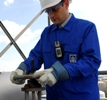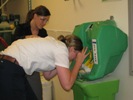
By Joseph Weigel
Electrical workplace safety deficiencies are among the top 10 violations most frequently cited by OSHA.
By Bill Sims Jr.
Behavioral science has proven countless times that both positive and punishing consequences affect our behavior.
By Jodi Groh
Are you seeing all of the barriers to protective eyewear compliance?
By Kami Blake
Some may assume that the lion's share of the responsibility is upstream, but downstream employers are not exempt.
By James R. White
What training have they had? Are they qualified to the NFPA 70E standard and to 29 CFR 1910.332, 1910.333, and 1910.269?
By Tom Jacques
Safety Data Sheets will for the most part grow exponentially. And they still will be written by technical professionals for technical professionals.

By Rick Wanek
2010 ACGIH guidelines provide an impetus for companies to collect H2S monitor data, allowing them to evaluate and refine their safety and hygiene programs.
By Russell J. Kendzior
Here's the story of how two OH&S case studies lead to a new national standard.
By Jerry Laws
Committee members are hard at work on the 2014 edition of the Guidelines for Design and Construction of Health Care Facilities.

By Steven Gray
They work in unison to help ensure that should a shower or facial flush become necessary, there is little risk of the injury's becoming more aggravated.
By Linda J. Sherrard
If injury potential is so predictable, why are employees so surprised when they are injured? Eye injuries may be predictable, but the exposures are not always apparent.
By Robert Pater
It's critical to first formulate and then transmit what you specifically wish to see changed, to what degree, by when and who, with what resources.
By Jerry Laws
Oct. 31 is the deadline for safety professionals to apply in the 10th Annual Safety Professional of the Year competition.